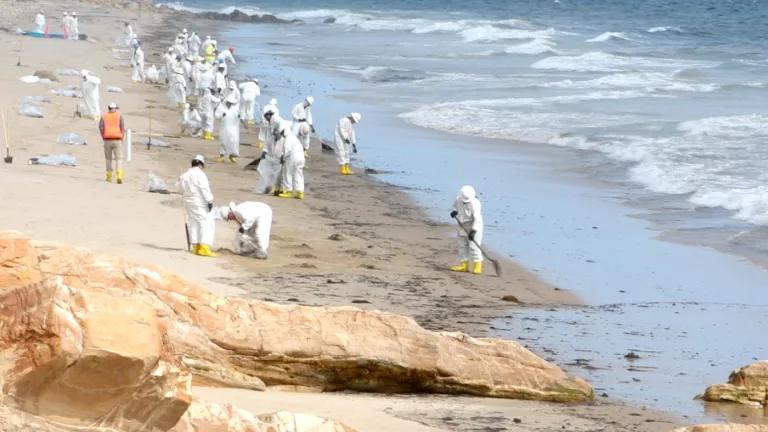I Hate Reruns
The Santa Barbara coast has yet another oil spill, thanks to a company that screws up royally—repeatedly.

When images of tar-stained beaches emerged out of Santa Barbara County on Tuesday, environmentalists and longtime residents experienced a painful moment of déjà vu. In 1969, a blowout on an offshore oil rig in the Santa Barbara Channel fouled the very same stretch of coast.
Thanks to inadequate safety precautions on the rig, an astounding three million gallons spewed straight into the water, where it killed thousands of seabirds, along with marine mammals like dolphins and elephant seals. At the time, it was the largest offshore oil disaster the country had ever seen. Now it takes the third slot (so much for progress).
Tuesday’s spill, thankfully, is much smaller—but that still isn’t saying much. The ruptured pipeline, operated by Texas-based Plains All American Pipeline, may have leaked up to 105,000 gallons—21,000 of which likely went into the ocean. In such an environmentally sensitive area like the sea cove currently besieged by crude, what amounts to a drop in the bucket in comparison to the 1969 spill’s volume still packs a major punch.
“Anytime you have oil spilled into the marine ecosystem, it’s a major threat for birds and other wildlife,” Brigid McCormick, executive director of Audubon California, said in a statement. “Even a tiny amount of oil can kill a bird.”
The area is known for its rich species diversity, including hundreds of species of fish and migrating whales. So far, the Oil Wildlife Care Network is rehabbing five oiled pelicans and one California sea lion, the group said in an update on Thursday. The oil slick currently spans nine miles, but Audubon reports that if it spreads south, it could begin to affect western snowy plovers nesting at the Coal Oil Point Reserve. The federally threatened birds are currently at the peak of their breeding season.
The spill may have economic consequences, too, if visitors skip over this tourist destination this summer. Refugio State Beach, near the site of the spill, and El Capitan State Beach are popular camping sites that would undoubtedly have been teeming with tents this Memorial Day weekend. Both are closed until further notice, along with a number of local fisheries.

On Wednesday, California governor Jerry Brown issued a state of emergency for Santa Barbara County. By Thursday afternoon, cleanup crews had recovered more than 8,358 gallons from the water. About 300 people are working on the spill around the clock in an effort the U.S. Coast Guard says may take months.
The aftermath of the 1969 spill didn’t end with its cleanup effort (and neither should this one). The previous disaster served as a dramatic and visual catalyst for some much-needed tightening of the country’s environmental legislation, including the formation of the U.S. Environmental Protection Agency, the National Environmental Policy Act, and the Clean Water Act. It also led to a ban on new offshore-drilling leases in California.
But this week’s pipeline rupture is a reminder of the risks that remain concerning the production and transport of oil.
Moving oil by pipeline is considered much safer than rail, but a single accident can have catastrophic consequences (as the residents of Kalamazoo, Michigan, or Mayflower, Arkansas, can surely attest). And Plains has a shoddy safety record by any standard. According to the Los Angeles Times, the company has racked up 175 safety and maintenance infractions since 2006, spilled more than 688,000 gallons of hazardous materials, and earned itself upwards of $23 million in damages. Its rate of incidents per mile of pipeline is more than three times the national average. Of the more than 1,700 pipeline operators listed in the Pipeline and Hazardous Materials Safety Administration’s database, only four have more safety infractions than this company.
As for the state of things offshore, drilling still looms large 46 years after the 1969 spill (and, of course, the Gulf catastrophe just five years ago). Yet President Obama recently proposed opening the East Coast to drilling, and Shell is moving forward with plans to drill in the Arctic—which, by the way, the Department of the Interior says comes with a 75 percent chance of a major spill.
I don’t know about you, but I’ve had enough of history repeating itself.
This article was originally published on onEarth, which is no longer in publication. onEarth was founded in 1979 as the Amicus Journal, an independent magazine of thought and opinion on the environment. All opinions expressed are those of the authors and do not necessarily reflect the policies or positions of NRDC. This article is available for online republication by news media outlets or nonprofits under these conditions: The writer(s) must be credited with a byline; you must note prominently that the article was originally published by NRDC.org and link to the original; the article cannot be edited (beyond simple things such grammar); you can’t resell the article in any form or grant republishing rights to other outlets; you can’t republish our material wholesale or automatically—you need to select articles individually; you can’t republish the photos or graphics on our site without specific permission; you should drop us a note to let us know when you’ve used one of our articles.

This Is How We Stand Up to Trump
A Beach of an Oil Spill
Why Florida Needs an Offshore Drilling Ban—One That’s Permanent